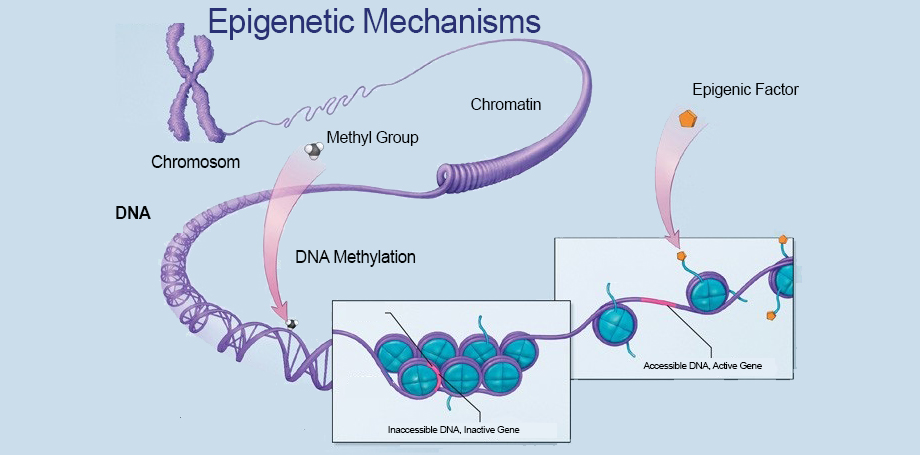Epigenetics as a source of inspiration for cosmetics
6
Nov
![[Translate to English:] Epigenetik und Kosmetik [Translate to English:] Epigenetik](/fileadmin/user_upload/ALL_BLOG/Titelbild_Epigenetik.jpg)
Epigenetics is attracting more and more interest from cosmetic brands, and epigenetically active ingredients count among the major innovations of recent years. Epigenetics is the field of biology that attempts to explain the extent to which environmental factors can reversibly alter our genes. It is precisely this aspect that makes epigenetics interesting for the cosmetics industry. Cosmetics manufacturers see a potential in epigenetics to counteract cell aging.
Each of our cells contains our entire genetic heritage: 46 chromosomes inherited from our parents, carrying about 25,000 genes that encode proteins. This part of our genome, which is called “coding DNA”, effectively only makes up about 2% of our total DNA. The remaining 98% was initially considered to be “junk DNA” until it was discovered that it performs important functions. These discoveries came especially out of epigenetics research.
The genome and its environment
Epigenetics investigates the extent to which external factors, such as environmental influences and individual habits or experiences, interact with genes and alter the expression of information in the DNA.

This can be studied very well in monozygotic twins, for example, who have exactly the same DNA and are perfectly identical in their childhood. During life, various environmental factors such as diet, disease, medication and toxins, stress, location and lifestyle change the gene expression of identical twins in different ways without affecting the actual DNA sequence.
Unlike mutations that directly influence the building blocks of DNA, these epigenetic modifications are reversible. They can be transferred to daughter cells and offspring, or disappear following a significant change in the environment and/or lifestyle.
Epigenetic mechanisms
For the information stored in a gene to be translated into a molecule, it must be readable. That means the gene must be accessible to the various protein complexes involved in this process.
Most epigenetic processes are based on chromatin modifications at the DNA or histone level, and can activate genes by making them readable, or repress them in response to environmental factors by making them unreadable.
So far, three key mechanisms have been identified, but it is suspected that many others exist that have yet to be discovered.
- DNA methylation: A methyl group can label the DNA and act as a gene activator or repressor. Low methylation promotes gene activity while high methylation inhibits it.
- Histone modification: Histones are proteins around which DNA is wrapped and compacted. The binding of epigenetic factors to the ends of histones influences the compactness of this wrapping, and can alter the accessibility of certain genes, thus favouring or preventing protein synthesis.
- Production of microRNAs: these can prevent messenger RNAs from transmitting their messages by neutralizing or destroying them.
Cosmetics and epigenetic aging
Epigenetics thus tries to explain the phenomena of cell aging and reactions to oxidative stress. In addition to cell aging, environmental pollution, UV radiation and other stress factors alter the epigenetics of skin cells. Even when no stress factors remain, the cells continue to age.
Recent research in the field of epigenetics shows that skin aging can be stopped, cells can be rejuvenated, and DNA damage can be reversed.... That inspires the cosmetic world and paves the way for developing a new generation of anti-aging cosmetic products!
Major luxury brands like Capture Youth by Dior, Slow-Age by Vichy, or Généfique by Lancôme are already interested in the potential of epigenetics.... It is similarly so for newly emerging brands like Epigeneva in Switzerland, Casmara in Spain, and Hydropeptid in the USA.
Epigenetic discoveries are yielding new modes of action in cosmetics, for example: influencing the formation of microRNAs to increase collagen or elastin production; stimulating receptors that are naturally present in the dermis; and activation of the skin’s innate youthful regenerative ability.
These new possibilities are of great interest to cosmetics brands, but there are hurdles to be overcome. Some relate to the marketing discourse: brands must prove that a cutaneous application has an effect on genes.
Others relate to the substantiation of claims: so far, the only studies proving that there are epigenetic effects have been in-vitro studies such as functional protein studies by western blot, DNA methylation analysis, or detection of specific microRNAs.
In connection with skin aging, epigenetics poses many challenges! Nevertheless, epigenetic approaches are inspiring the cosmetics industry and it is a near certainty that, one day, there will be epigenetics-inspired care products in every bathroom.


Comments are disabled for this post.